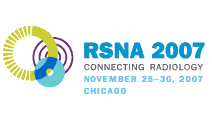
Abstract Archives of the RSNA, 2007
Alexander Wall MD, Presenter: Nothing to Disclose
Michel Eisenblaetter, Abstract Co-Author: Nothing to Disclose
Jan Ehrchen, Abstract Co-Author: Nothing to Disclose
Johannes Roth MD, Abstract Co-Author: Nothing to Disclose
Walter Leonhard Heindel MD, Abstract Co-Author: Nothing to Disclose
Christoph Bernhard Bremer MD, Abstract Co-Author: Nothing to Disclose
To establish a new model for imaging the process of early inflammation using fluorochrome-labelled macrophages combined with planar (Fluorescence Reflectance Imaging; FRI) and tomographic (Fluorescence Mediated Tomography; FMT) near-infrared imaging techniques.
Murine macrophages were labelled with a membrane selective carbocyanine dye (DiR). Viability and function (apoptosis rate, NO-production, adhesion function and phagocytosis) of labelled cells were assessed in vitro. Local inflammation was induced in both flanks of nude mice by s.c. injection of biogel pellets in- or excluding a strong inflammatory stimulus (lipopolysaccharides, LPS). Labelled macrophages (1 x 107) were injected i.v. and FRI and FMT were performed daily up to 7 days post injection. Signal–to-noise ratio (SNR) was calculated for the implanted pellets and the 3-D distribution of macrophages was assessed using FMT. To confirm transendothelial migration of labelled cells, gel pellets were harvested and the cellular infiltrate was analysed by flow cytometry.
The labelling procedure did not result in impairment of viability or cellular function. LPS-containing pellets exhibited significantly higher SNR compared to pellets without LPS (529±292 AU vs. 273±172 AU; p < 0.05; n = 5). FMT confirmed the FRI data and showed macrophages distributed mainly in the periphery of the pellets resulting in approximately 1.8x higher fluorescence signal in LPS containing pellets compared to controls (459±295 vs. 253±168 p < 0.05; n = 10). FACS analysis of the cellular infiltrates extracted from the harvested pellets showed approximately 20% DiR positive cells expressing typical macrophage surface markers (F4/80, CD115) and therefore confirmed the imaging findings.
Tagging of macrophages with a membrane selective fluorochrome allows non invasive cell tracking for several days in vivo. FRI and FMT are versatile techniques to monitor and potentially quantify cellular inflammatory response in vivo.
We developed a new method for imaging of temporal and spatial aspects of early inflammation using labelled macrophages and planar (FRI) as well as tomographic (FMT) near-infrared imaging techniques.
Wall, A,
Eisenblaetter, M,
Ehrchen, J,
Roth, J,
Heindel, W,
Bremer, C,
In vivo Optical Imaging of Cellular Inflammatory Response in Granuloma Formation Using Fluorescence Labelled Macrophages. Radiological Society of North America 2007 Scientific Assembly and Annual Meeting, November 25 - November 30, 2007 ,Chicago IL.
http://archive.rsna.org/2007/5006440.html

